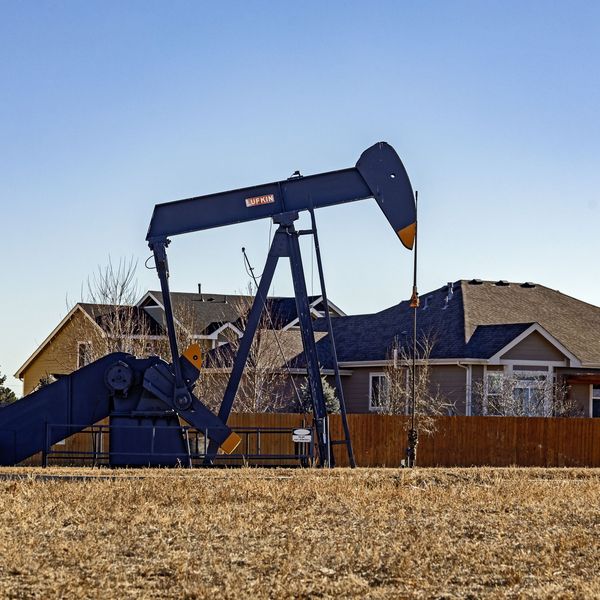'Alarmingly High Methane Emissions' from Natural Gas Extraction
New findings suggest higher than previously noted levels of potent greenhouse gas leaked
New research on "alarmingly high methane emissions" brings further environmental scrutiny to natural gas extraction including fracking, and illustrates how the boom in the industry may well be a plan for climate disaster.
The findings, led by researchers at the National Oceanic and Atmospheric Administration (NOAA), were presented at the American Geophysical Union (AGU) meeting in San Francisco, the journal Nature reports, and reiterated data the team first noted in February of 2012 that 4% of the methane produced at a field near Denver was escaping into the atmosphere. The team also presented preliminary findings from a Utah study that suggested an even higher rate of methane emissions--9% of the total production.
NOAA describes methane as 25 times more potent of a greenhouse gas than CO2.
"We were expecting to see high methane levels, but I don't think anybody really comprehended the true magnitude of what we would see," says Colm Sweeney, who led the aerial component of the study as head of the aircraft program at NOAA's Earth System Research Laboratory in Boulder.
Jeff Tollefson explains in Nature that the percentage of methane leaked is key to determining whether switching to natural gas from coal-fired generators has a climate benefit; it must be less than 3.2% for that to be the case, he writes.
The Obama administration has embraced fracking as part of its "all-of-the-above" energy strategy.
An Urgent Message From Our Co-Founder
Dear Common Dreams reader, The U.S. is on a fast track to authoritarianism like nothing I've ever seen. Meanwhile, corporate news outlets are utterly capitulating to Trump, twisting their coverage to avoid drawing his ire while lining up to stuff cash in his pockets. That's why I believe that Common Dreams is doing the best and most consequential reporting that we've ever done. Our small but mighty team is a progressive reporting powerhouse, covering the news every day that the corporate media never will. Our mission has always been simple: To inform. To inspire. And to ignite change for the common good. Now here's the key piece that I want all our readers to understand: None of this would be possible without your financial support. That's not just some fundraising cliche. It's the absolute and literal truth. We don't accept corporate advertising and never will. We don't have a paywall because we don't think people should be blocked from critical news based on their ability to pay. Everything we do is funded by the donations of readers like you. Will you donate now to help power the nonprofit, independent reporting of Common Dreams? Thank you for being a vital member of our community. Together, we can keep independent journalism alive when it’s needed most. - Craig Brown, Co-founder |
New research on "alarmingly high methane emissions" brings further environmental scrutiny to natural gas extraction including fracking, and illustrates how the boom in the industry may well be a plan for climate disaster.
The findings, led by researchers at the National Oceanic and Atmospheric Administration (NOAA), were presented at the American Geophysical Union (AGU) meeting in San Francisco, the journal Nature reports, and reiterated data the team first noted in February of 2012 that 4% of the methane produced at a field near Denver was escaping into the atmosphere. The team also presented preliminary findings from a Utah study that suggested an even higher rate of methane emissions--9% of the total production.
NOAA describes methane as 25 times more potent of a greenhouse gas than CO2.
"We were expecting to see high methane levels, but I don't think anybody really comprehended the true magnitude of what we would see," says Colm Sweeney, who led the aerial component of the study as head of the aircraft program at NOAA's Earth System Research Laboratory in Boulder.
Jeff Tollefson explains in Nature that the percentage of methane leaked is key to determining whether switching to natural gas from coal-fired generators has a climate benefit; it must be less than 3.2% for that to be the case, he writes.
The Obama administration has embraced fracking as part of its "all-of-the-above" energy strategy.
New research on "alarmingly high methane emissions" brings further environmental scrutiny to natural gas extraction including fracking, and illustrates how the boom in the industry may well be a plan for climate disaster.
The findings, led by researchers at the National Oceanic and Atmospheric Administration (NOAA), were presented at the American Geophysical Union (AGU) meeting in San Francisco, the journal Nature reports, and reiterated data the team first noted in February of 2012 that 4% of the methane produced at a field near Denver was escaping into the atmosphere. The team also presented preliminary findings from a Utah study that suggested an even higher rate of methane emissions--9% of the total production.
NOAA describes methane as 25 times more potent of a greenhouse gas than CO2.
"We were expecting to see high methane levels, but I don't think anybody really comprehended the true magnitude of what we would see," says Colm Sweeney, who led the aerial component of the study as head of the aircraft program at NOAA's Earth System Research Laboratory in Boulder.
Jeff Tollefson explains in Nature that the percentage of methane leaked is key to determining whether switching to natural gas from coal-fired generators has a climate benefit; it must be less than 3.2% for that to be the case, he writes.
The Obama administration has embraced fracking as part of its "all-of-the-above" energy strategy.

